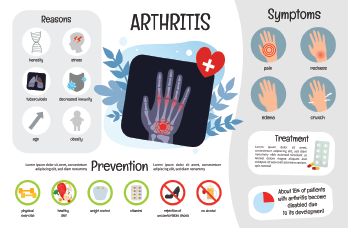
Igdeeva Alena / shutterstock.com
ATLANTA—Rheumatic diseases have been the subject of a range of public health campaigns and reports over the past decade, but improving their visibility remains a work in progress, a Centers for Disease Control and Prevention (CDC) expert said at the 2019 ACR/ARP Annual Meeting. A growing attention to pain and the opioid crisis may help in this regard, he said.
Charles (Chad) Helmick, MD, a medical epidemiologist and the scientific lead for the CDC’s arthritis program, said the organization, in collaboration with many other groups and universities, is continuing in its push.
“The overriding issue in my mind is the need for greater visibility for arthritis and other rheumatic conditions as important health problems,” he said.
When Dr. Helmick created the CDC’s arthritis program in 1999, he was cautioned about the challenge that lay ahead of him, mainly because rheumatic conditions are not among the major, deadly diseases, such as cancer and cardiovascular disease, that occupy so much space in the public consciousness.
“‘This is not a fatal disease—you’re sort of leading the way for a lot of other chronic, non-fatal disabling diseases,’” he recalled being told. “And it’s tough. We’ve worked on it, and I think we’ve done a lot of successful things over that time.”
Burden of Rheumatic Conditions
The burden of rheumatic conditions continues to be great in the U.S. According to CDC reports covering 2013–15, 54 million adults, or 22.7% of the adult population, had arthritis, and 22.7 million adults, or 43.5%, had limitations to activity they attributed to arthritis.1 By 2040, the CDC’s National Health Interview Survey predicts 78 million adults will have arthritis, and that is almost certainly an underestimate because it counts only the change based on the population structure by age, Dr. Helmick said.
“It does not take into account the obesity epidemic, which I think will make this number even higher,” he cautioned.
In 2013, the cost attributed to arthritis was $304 billion–140 billion in medical costs and $164 billion in lost earnings. That’s equal to $2,117 in medical costs per adult with arthritis, and $4,040 less in pay for an adult with arthritis vs. an adult without arthritis.2
In an assessment of adults with arthritis across the states, a median of 30.3% had severe joint pain, with Colorado having the lowest percentage at 20.8% and Mississippi the highest at 45.2%.3
A Major Cause of Disability
Research has found the main causes of disability among adults in the U.S. are arthritis or rheumatism, just ahead of back or spine problems.4 “They were way ahead of some of the other big things, like heart disease and diabetes and mental health problems,” Dr. Helmick said.

Dr. Helmick
Although arthritis and rheumatism are more common among people older than 65, more people who are younger than 65 actually have arthritis, so the condition has big effects on work. According to the National Health Interview Survey, the most common causes of work disability are back or neck problems, which account for 30%; depression and anxiety, accounting for 21%; and arthritis and rheumatism, accounting for 19%. Making matters worse, arthritis is frequently seen alongside other chronic conditions: From 2013–15, the survey found 49% of those with heart disease also had arthritis, as did 47% of diabetes patients and 31% of obese people.
“In all three of these diseases, physical activity is the recommended management, so if you’re not being physically active, you’re not getting the proper management for your diseases,” Dr. Helmick said. “And the people who have these diseases plus arthritis are much less physically active than those who have the disease and don’t have arthritis. So arthritis is really a specific barrier to being physically active.”
Researchers have also found that people with arthritis report 10 of the previous 30 days as “unhealthy” days, either physically or mentally, compared with 4.8 of the previous 30 for those without arthritis.5
Interventions from a public health perspective include not only physical activity, but education on how to self-manage, and research into prevention to strengthen the scientific basis for community interventions, Dr. Helmick said. Continued funding for state and national programs is needed to raise visibility and make inventions more available because people are more likely to participate in settings in the community than in typical clinical settings, he said.
Arthritis Awareness Campaigns
From 1999’s National Arthritis Action Plan to the National Public Health Agenda for Lupus: A Blueprint for Action in 2015 to its appearance in the CDC’s high-visibility Vital Signs reports and articles in the Morbidity and Mortality Weekly Report, arthritis awareness has been promoted by the CDC and other federal agencies.
Among other goals, the Healthy People 2020 campaign attempts to “attain high-quality, longer lives free of preventable disease, disability, injury and premature death.” The campaign includes several arthritis objectives, including the reduction of pain, activity limitations and employment issues. The 2030 campaign also includes objectives regarding arthritis.
Benefiting from Increased Attention to Pain Issues
Dr. Helmick also discussed how increased attention to generic pain issues and the opioid crisis may help raise the profile of arthritis as a public health threat. Such organizations as the Institute of Medicine, the U.S. Department of Health & Human Services and the White House have also made pain a primary focus, largely with the goal of reducing addiction to opioids. Pain reduction is a goal that is closely aligned with rheumatic disease treatment and awareness, Dr. Helmick said.
The National Institutes of Health’s $945 million HEAL initiative—Helping to End Addiction Long-Term—will include money for research on pain signatures associated with the transition from acute to chronic pain, how to manage pain more effectively and optimizing non-addictive therapies to treat pain. With pain as an important outcome, “arthritis is positioned to take advantage,” he said.
“Arthritis and rheumatic conditions are major sources of chronic pain, so more general attention to pain, as has been happening over the past seven years—and pain as a major risk factor for prescribed opioids, which is a large part of the current opioid crisis—mean that arthritis and rheumatic conditions should be getting more attention from both the pain and opioid communities as part of their own agendas.”
Thomas R. Collins is a freelance writer living in South Florida.
References
- Barbour KE, Helmick CG, Boring M, et al. Vital signs: Prevalence of doctor-diagnosed arthritis and arthritis-attributable activity limitation–United States, 2013–2015. MMWR Morb Mortal Wkly Rep. 2017 Mar 10;66(9):246–253.
- Murphy LB, Cisternas MG, Pasta DJ, et al. Medical expenditures and earnings losses among US adults with arthritis in 2013. Arthritis Care Res (Hoboken). 2018 Jun;70(6):869–876.
- Guglielmo D, Murphy LB, Boring MA, et al. State-specific severe joint pain and physical inactivity among adults with arthritis—United States, 2017. MMWR Morb Mortal Wkly Rep. 2019 May 3;68(17):381–387.
- Theis KA, Steinweg A, Helmick CG, et al. Which one? What kind? How many? Types, causes, and prevalence of disability among U.S. adults. Disabil Health J. 2019 Jul;12(3):411–421.
- Furner SE, Hootman JM, Helmick CG, et al. Health-related quality of life of US adults with arthritis: Analysis of data from the behavioral risk factor surveillance system, 2003, 2005, and 2007. Arthritis Care Res (Hoboken). 2011 Jun;63(6):788–799.



